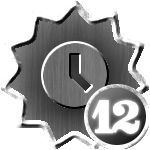-
Posts
261 -
Joined
-
Last visited
About EldKatt

- Birthday 10/04/1988
EldKatt's Achievements
-
You might also want to look into Edition K
-
OK, great. You have a clear opinion on an aesthetic issue of interpretation. A bunch of other people have a different one. That's it. What puzzles me the most about this thread is that you haven't made any effort to explain why it's stupid to prefer two hammer strokes--except for the single clearly stated motivation, "3 is a magic number", which, in all honesty, isn't very convincing--you merely respond with continued bafflement that not everyone understands whatever it is that you understand. I don't see what keeps this thread going.
-
There's also the title "A guide for modern composers" (if that is your idea or the editor's I don't know, though), which I think might misrepresent your intentions a bit. Anyway, fine, you thought you made it clear--evidently not everyone thinks so. You asked for comments and suggestions, and that's what you're getting. Please be grateful for them and take them in--then feel free to ignore them if you think they're stupid, or discuss or ask for clarifications in a civil manner. People might not be too keen on helping you if they think you'll respond to criticism merely by suggesting that they didn't read carefully enough. Unless you want positive comments only, I guess, which is fine by me...
-
This should be the slogan for the MPAA's next anti-piracy campaign. Sorry for the tangent, folks. I just find this hilarious.
-
I think this part is key. I'd say the concept of "classical music" as different from other music generally has to do more with historical, cultural and social context than with anything else (certainly not effort!). The historical, cultural and social context of jazz is largely different, and this is why they are often conceptually separated. But what primarily sets it apart from popular music is that it isn't popular, right? ;) On a more serious note, I don't think it's constructive or appropriate, in a serious discussion of music on anything but the most shallow of levels, to use terms like "sophisticated" and "interesting" to classify and define things. Not only will it make it harder to come to any real and truly interesting conclusions about the actual characteristics of or differences between various forms of musical expression--you'll also find that it will make you unpopular with a lot of people. (Written before I saw Gardener's post. Not that it matters a lot.)
-
Please. I hope we're all aware that opinions are not facts. Does that mean that it's pointless to discuss them? Can't I have opinions about your opinions, and you about mine? If only facts are even worth talking about, and opinions are too holy to discuss, then what are we all doing here? Subjectivity's a scallop, okay, and with that argument taken at its full power, there's nothing left to talk about here. Show's over. Really, those are not the premises of a discussion. I respect Nicola's right to withdraw from a discussion, or to avoid entering one--good on ya--but trying to make SSC look like a fool for discussing something, which is what we all are doing here, Nicola included, is just not nice, and not honest. Without at all going into my opinions on whatever you were talking about, those are my thoughts about the discussion itself. Just stay calm and friendly and honest... and then disagree with each other as much as you like.
-
Another musical audition rule that I've seen mentioned in countless threads like this in other forums is no Sondheim. I lack the experience to have any personal opinion of the validity of this rule. Supposedly the reason is that the accompaniments are generally more complex than the typical Broadway idiom. Depending on who the pianist is this may or may not be a valid point--but if it is, it's in your interest that you get decent accompaniment. If you don't know that the accompanist will be an excellent sight-reader, it's probably good advice for much of the Sondheim repertoire. For Pirelli I assume you'd want to show some height, but beyond that, like Dead Chicken said, it really depends on you. "Something Italian" (by which I assume you mean something classical) and something from JCS may both be possible choices, but they are very different in the kind of vocal qualities they show. Which do you think you can make a good impression with? Rather than showing them what you think they want to see, it's more important that you show who you are and what you can do. That's what they really want to see.
-
Sure it is. But the theme itself is only more significant than any other sequence of four notes because the note names (a very abstract and inaudible thing) coincide with the composer's name (which is also very abstract, and, if you think about it, impersonal; it could have been anything else). I think this is as detached and unmusical as using pi. The meaning and emotion do not come from the letters or the name. You're probably right. What if he were touched by the beauty of a tone row derived from pi? I don't see how we're in disagreement here... To be perfectly honest, I think you're just disagreeing for the sake of disagreeing, because my post clearly positioned me on the side opposite yours in this discussion. Why is it that internet debates always turn into a two-team effort?
-
So the key difference, if I understand you correctly, is the use of preexisting and unalterable source material, and thus basing pitch content on pi is less artistic than basing pitch content on divine inspiration? Just to make sure you're considering all the implications of your philosophical conjecture here, how about other extramusical or extrapersonal sources of inspiration? When Shostakovich uses the DSCH motif, or Bach the BACH motif (as he himself did consciously at least once, and numerous others have since), is the music suddenly, automatically, moved a few steps down on the spiritual ladder and turned into something less artistic? These motifs in themselves are certainly not an intimate expression of anybody's inner self, they could not have been altered without defeating their purpose, and they're based on something nearly as stereotypically dry, intellectual and boring as numbers: letters. How about when Messiaen uses birdsong? Birds are cool and look good and live outdoors (oh, and they can fly), so they're not nearly as dull and dead as numbers, which are used by such soulless people as mathematicians and scientists, but the fact remains that Messiaen didn't dig deep into his own soul to make up their songs—the birds did. The key component in the craft of musical composition, and what makes a master a master, is not where the musical material is found—it is how it's used. I'm sure we can all agree on this. How a few rudimentary ideas are built into a symphony; how the material develops and interacts over time; how eventually the listener is left with the memory of an experience far more profound and meaningful than the individual building blocks themselves. In a narrative such as a novel or play—an art form similar to music in that both are occupied with events occurring over time—the meaning and emotional impact comes not from the characters themselves, but from how they interact, develop and influence each other during the course of the narrative. With these things in mind, how much does it really matter where the basic building blocks came from?
-

XVI Century Counterpoint 2 voices 3rd species - I
EldKatt replied to composerorganist's topic in Advice and Techniques
Ah, sorry for ruining your lesson plan, then. :P I'm not sure Jeppesen would agree about that. These two bars are virtually identical to the example he calls "especially [...] unusable". -

XVI Century Counterpoint 2 voices 3rd species - I
EldKatt replied to composerorganist's topic in Advice and Techniques
So am I right in thinking that this thread is for writing single melodies in quarter notes only, and two-part counterpoint should wait until the second part, when rules regarding harmony and dissonance treatment (now missing entirely) are introduced? There also seem to be some melodic rules missing from this thread--such as the treatment of unaccented quarters approached by step from below (should preferably continue upward by step), and the use of upper auxiliary notes (to be avoided altogether on unaccented quarters, and possibly in other circumstances). -
If anyone else thought, as I did, upon reading this thread, "Gee, I wonder just how close these numbers really are to the golden ratio," no need to think further. I have no idea if it interests anyone (probably not), but I already did the number-crunching, so I might as well post the results here. title climax total ratio 1/ratio (seconds) A Boy And A Girl 168 268 0.627 1.595 Cloudburst 309 492 0.628 1.592 The Cow 39 62 0.629 1.590 Go Lovely Rose 163 257 0.634 1.577 The Kangaroo 24 38 0.632 1.583 The Panther 31 48 0.646 1.548 Her Sacred Spirit Soars 236 396 0.596 1.678 The Seal Lullaby 138 225 0.613 1.630 Sleep 213 340 0.626 1.596 The Stolen Child 330 520 0.635 1.576 When David Heard 550 894 0.615 1.625 The actual golden ratio 0.618 1.618 [/CODE] Make your own conclusions. Based on the data alone, I think it seems close enough to be interesting, but if you want to draw conclusions beyond "it's interesting", you have to take into account first the selection of pieces (is it random? Were other "measurements" taken that didn't fulfill the criteria? How large is the collected body of Whitacre's works?), and then the definition of "climax" (may well be very difficult--or might not be). Also, with the data itself you might also think about what kind of deviations can be expected in the compositions themselves (due to climaxes out of necessity falling on specific points in a phrase or bar), and in the recording (rubato, silence at the beginning or end of tracks), in order to gauge how far off the ratio can be and still count as a hit. Although I believe this subject doesn't hold much [i]musical[/i] or artistic value, I'm not quite as inclined to dismiss this as wholly coincidental or uninteresting as flint seems to be. Still, points like the above need to be taken into account if any scientific conclusions are to be drawn.
-
The most reasonable interpretation I can think of (although I'm no string player) is that these are arpeggiated quadruple stops, made up of harmonics. Each of the four notes is played on its own string, and the left hand doesn't have to move at all. This kind of notation, were the noteheads ordinary ones, would without question suggest an arpeggiation of that sort, and is a common string idiom. This device is new to me, but I imagine it's no more difficult for the players. In the first violin, the G string is fingered at B (sounding as the B two octaves above), the D string at G (sounding D two octaves above, like an ordinary "touch fourth" artificial harmonic, but natural), the A string at E (sounding E an octave above) and the E string at B (sounding B an octave above). You'll find that the violas and cellos are playing the exact same fingerings on their instruments, sounding (from the bottom) as E, G, A, E (in various octaves that you can calculate if you like). A string player might be able to comment on the feasibility of fingering that chord. I've always assumed it to be good practice to avoid writing multiple stops with fifths (except of course on open strings), where two strings would have to be fingered at the same position--although that whole matter might better be the subject of another thread, does the fact that these are harmonics make it easier to deal with?
-
You've written it in the title tag of the mp3: BWV 808. It's the first gavotte (not a minuet) from the 3rd English Suite, as the file name says. Something tells me that deep down, you already knew this (at some point at least). :P
-
Although I haven't been following this discussion... I don't think anyone would call the existence of perfect fifths in separate musical systems a coincidence--for reasons we should all be familiar with, although the numbers 660 and 880 (and their relationship) is a clue. Drawing from that any conclusions about tonality is a bit of a stretch, though, isn't it?



